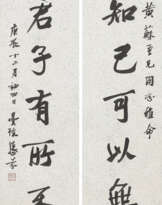DENG FEN (1894-1964), FENG XIANGBI (1896-1974), ZHANG CHUNCHU (1869-1943), ZHANG XIANGNING (1911-1958) AND YU KUANGFU (20TH CENTURY)
29.05.2022 10:00UTC +08:00
Classic
Vendu
478800HKD HKD 478 800
| Auctioneer | CHRISTIE'S |
|---|---|
| Lieu de l'événement | Hong Kong, Hong Kong |
Archive
La vente aux enchères est terminée. Vous ne pouvez plus enchérir.

ID 770114
Lot 1052 | DENG FEN (1894-1964), FENG XIANGBI (1896-1974), ZHANG CHUNCHU (1869-1943), ZHANG XIANGNING (1911-1958) AND YU KUANGFU (20TH CENTURY)
Valeur estimée
HKD 200 000 – 300 000
| Adresse de l'enchère |
CHRISTIE'S 18 Chater Road Central Hong Kong Hong Kong | ||||||||||||||
|---|---|---|---|---|---|---|---|---|---|---|---|---|---|---|---|
| Aperçu |
| ||||||||||||||
| Téléphone | +85227601766 | ||||||||||||||
| Fax | +852 2760 1767 | ||||||||||||||
| Conditions d'utilisation | Conditions d'utilisation | ||||||||||||||
| Heures d'ouverture | Heures d'ouverture
|










